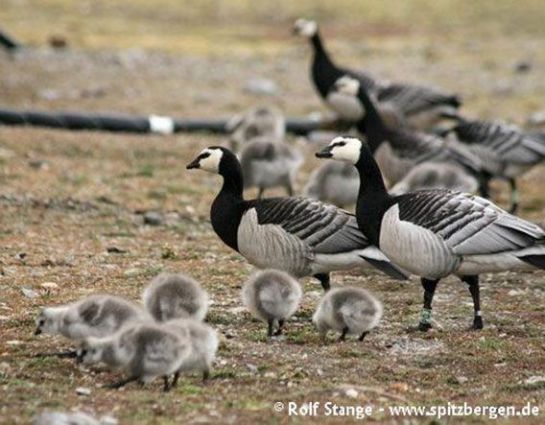Hvitkinngås, a Coldwater Coast Colonist
Dr. James J. S. Johnson

BARNACLE GOOSE flock in flight (credit: BirdGuides)
And pray ye that your flight be not in the winter. (Mark 13:18)
The above-quoted Scripture refers to the “flight” of human refugees, during a time of future world crisis. However, for migratory birds, long-distance flights are not deemed a “crisis” because they are an ordinary twice-yearly lifestyle — winging from breeding grounds (as summer fades into autumn) to wherever it overwinters, usually with stopover breaks along the way, then vice versa (during spring).
For the BARNACLE GOOSE (called Hvitkinngås in Norwegian, literally “white-cheek goose”), however, the breeding grounds are fairly frigid, with that anatid dwelling mostly in four populations: (1) east Greenland breeders, who overwinter mostly along the western coasts of the British Isles, especially in the Hebrides (e.g., Islay) and western Ireland; (2) Svalbard’s breeders, who overwinter in and near the Irish Sea’s Solway Firth, that separates England and Scotland, not far from the Isle of man; (3) Russian breeders, some summering at or near Novaya Zemlya, or its neighboring Siberian coastland, who overwinter in the Netherlands or nearby Germany; and (4) an unusual not-so-migratory eastern colony, which appear to have abandoned the Russian population, and are now resettled (and mostly residing year-round!) in and near islands and coastlands of the Baltic Sea, including coastal Estonia, Finland, and Sweden (although some of these “transplants” may overwinter in and around Netherlands).
One of Norway’s most extreme territories is the arctic archipelago of Svalbard, the largest island of which is Spitsbergen. Svalbard hosts one of the world’s three most-northern breeding populations of migrating Barnacle Goose (Norwegian: Hvitkinngås, meaning “white-cheek goose”) colonies. Imagine the goslings hatched there each year!

Barnacle Goose group (credit: http://www.-spitzbergen-svalbard.com / Rolf Stange)
According to the Norwegian Polar Institute:
“The barnacle goose (Branta leucopsis) is a medium sized, black and white goose … occu[ring] in three separate populations that breed [first] in northeast Greenland, [second] in Svalbard[,] and [third] in northwest Russia and the Baltic region … [with those] from Greenland winter[ing] in Ireland and in the western parts of Scotland, [while] the Svalbard birds spend the winter in the Solway Firth between England and Scotland” and the Russian population “winters along the western coasts of Germany and the Netherlands”.
[Quoting from “Barnacle Goose (Branta leucopsis)”, http://www.npolar.no/en/species/barnacle-geese.html .]
Also according to the Norwegian Polar Institute, the Svalbard-breeding population looks just like the other white-cheeked geese: “The Svalbard barnacle goose is indistinguishable morphologically from birds in the other populations, but is geographically isolated. In Svalbard, the barnacle goose breeds on the western coast of Spitsbergen and within Tusenøyane south of Edgeøya” – while “most barnacle geese breed in colonies on small islands, but some pairs also breed on cliffs on Spitsbergen.”
But as weather warms after winter, and daylight hours stretch (vs. night darkness), the northward migration repeats; breeding occurs in the arctic north:
“The spring migration starts in April or early May, when the geese leave Solway Firth and head for Helgeland on the western coast of mainland Norway. In the second half of May they move on to the southern part of Spitsbergen before reaching the nesting areas toward the end of May. In late August or early September the autumn migration starts. Bjørnøya is an important stop-over site where the birds can spend up to three weeks waiting for favourable winds to initiate migration to the wintering grounds in northern Britain. Some birds probably migrate directly from Spitsbergen to the Solway Firth.”
[Quoting “Barnacle Goose (Branta leucopsis)”, http://www.npolar.no/en/species/barnacle-geese.html .]
As a previous blogpost indicates, this “new” eastern (Baltic coastlands) population may be the result of Novaya Zemlya breeders who wisely abandoned that Russian archipelago due to the USSR’s hydrogen bomb [“Ivan”, the Russian Царь-бомба, i.e., “Tsar Bomb”] testing there.
[See “What’s Good for the Goose … May be Relocating (to Another Summer Home)”, posted at https://leesbird.com/2017/07/10/whats-good-for-the-goose-may-be-relocating-to-another-summer-home/ . ]

Barnacle Goose range map (Wikipedia Commons)
And now for a quick limerick poem about this white-cheeked goose’s migrations.
Hvitkinngås, Migrating Over Cold Oceans and Seas
Barnacle Geese are God’s creation,
Mobilized marvels of migration;
Far, far north they’ll do their breeding,
Thereafter they’ll be southward speeding,
For winter months of warm vacation.

Barnacle Goose pair, in Kaivopuisto, Helsinki, Finland (Juha Matti / Picssr)
Thanks, James for another limerick about a very interesting migrating behavior of The Creator’s Barnacle Geese.
LikeLike
Most interesting post James, thanks :-)
LikeLiked by 1 person